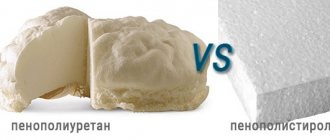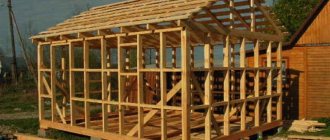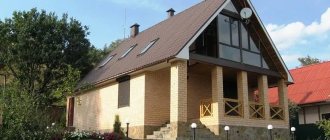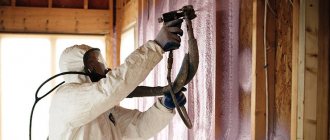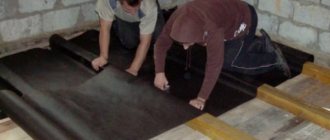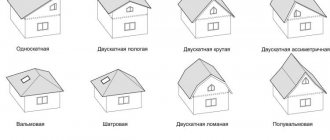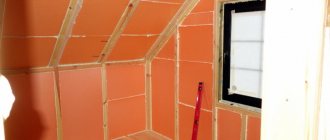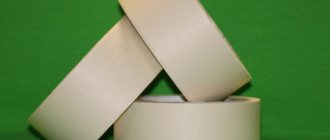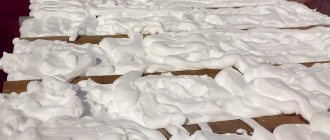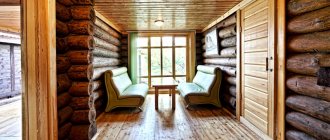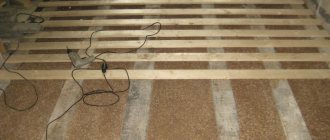Owners of private houses with basement insulation from the inside can supplement the useful space of their home not only with a spacious basement. If desired, they can also equip an attic - a room under the roof (essentially the same attic, only landscaped).
Insulated attic from the inside
If various workshops are usually located in the basement, then the attic often serves as another bedroom. However, in order for it to be fully used as a living space during the cold season, it is necessary to take care of insulation. And the best solution to solve this issue is PPU - or sprayed polyurethane foam.
1Features of attic insulation
Installing insulation for the attic from the inside, as well as insulating a well from concrete rings, is a much more complex and time-consuming task than insulating an ordinary room. The difficulty lies in the following factors:
- lack of horizontal overlap on top - that is, insulation will have to be done directly along the inner surface of the roof, which usually has a triangular shape; low temperature in the attic in winter; moisture may get inside, onto the surface of the insulation (this happens when the roof is damaged) - which not every insulator can withstand.
For these reasons, the use of most other materials, if possible, will be a very, very difficult task.
By the way, regarding the relevance of the process itself: thermal insulation of the attic from the inside is needed not only in cases where it is planned to equip a living space. Even if you are not going to use the attic in any way, it still needs to be insulated.
The reason is simple: the lack of insulation leads to the fact that the temperature above the ceiling (that is, in the attic) in winter will tend to the street temperature. In addition, it is quite possible that it will also be damp inside - since the roof covering often has leaks (and if not, they can appear over time).
Spraying polyurethane foam between the joists from the inside
As a result, moisture from natural precipitation will seep into the attic, spoiling its microclimate.
Dampness, in turn, can lead to the appearance of fungus and mold, and they can appear not only in the attic itself, but also from the inside, in the living quarters of the second floor. This problem is especially relevant for owners of wooden houses with polystyrene foam - after all, wood is most “afraid” of contact with water.
Methods for insulating the attic
In order to figure out how to insulate an attic roof for winter living, you need to know that there are several insulation options: internal and external.
Insulating the roof from the outside is an ideal option, since such a structure will not let in heat from the inside due to the warm circuit and will be reliably protected from freezing. This prevents the formation of condensation, therefore, the risk of mold and mildew is minimized. However, if the attic roof is already covered with roofing material, then insulating it will be extremely difficult, and the roofing material will have to be removed.
Most often, the attic is heated for further living in it from the inside. For this purpose, a wooden frame is being erected in the attic, which will serve as a niche for laying insulation. There are various technologies for thermal insulation.
External insulation of the attic occurs during the construction of the building. The gable roof is insulated. Internal thermal insulation is carried out with the roofing material already covered (if there is a need to make this room comfortable for living at any time of the year).
External thermal insulation
A ventilation hole with a diameter of at least 2 centimeters should be drawn through the layers of insulation. It is necessary to remove steam and condensate from the vapor barrier membrane. These holes are made in both the upper and lower parts of the roof slope. Thus, the air flows from bottom to top along the hole, collecting excess moisture from the vapor barrier film along the way and removing it out through the top hole.
However, all work on external insulation of the attic is carried out exclusively in the warm season in dry, sunny weather. All surfaces are carefully examined for any defects before thermal insulation. All areas must be dry. The wood must be impregnated with antiseptics. To prevent corrosion, metal surfaces are treated with butyme mastic.
External insulation of the attic occurs as follows:
- Lathing from boards is stuffed from the bottom of the rafters
- Vapor barrier film covers the sheathing and rafters
- Insulation is laid between the rafters
- The thermal insulation material is covered with steam and waterproofing on top
- The sheathing of boards is stuffed over the insulation
- The roofing material is attached using self-tapping screws to the sheathing.
https://youtube.com/watch?v=wyqkTCuRs4k
Internal thermal insulation
When choosing a material for thermal insulation, you need to pay close attention to its characteristics. It should be relatively light and easy to install without overloading the attic floor
It is also advisable to use environmentally friendly and fire-resistant material.
It is best to use basalt insulation; it is laid without the formation of cracks or voids. If insulation is used in the form of slabs, then the gaps must be filled with foam. When covering a vapor barrier membrane, you need to remember that the insulation sheets must have an overlap of no less than 20-30 mm.
When insulating a room internally, the procedure for carrying out work is as follows:
- The lathing is placed on the rafters or a specially prepared frame.
- To prevent wind penetration, the structure is covered with a protective film.
- A layer of thermal insulation is laid between the rafters and the frame.
- A vapor barrier membrane is placed on top of the insulation.
- The sheathing for the ventilation hole is stuffed over this structure.
- The sheathing is sheathed on top with plasterboard sheets or OSB boards.
When deciding to insulate a room with your own hands, you need to look at how to insulate an attic for winter living. The video will help with this. It covers in detail all stages of the work.
Today, many people are in a hurry to leave the noisy metropolis and find themselves in the lap of nature, which energizes and gives cheerfulness and new strength. It’s a rare person who doesn’t dream of living outside the city and enjoying the fresh air every day. However, in doing so, he faces some difficulties, because climatic conditions do not allow carefree living alone with nature all year round.
Creating favorable conditions for living in a country house is not an easy task, and this article aims to help overcome difficulties. Create coziness in your home, and let a warm and comfortable atmosphere always reign in it!
2About the material and its features
Now it’s important to touch on the properties and characteristics of the polyurethane foam itself. The use of sprayed insulation is a relatively new word for our market, but this technology quickly began to replace outdated mineral wool and foam insulation.
By the way, every person has seen polyurethane foam in one of its forms more than once - this is ordinary foam rubber used for padding upholstered furniture and entrance doors. Foam rubber is the so-called elastic polyurethane foam, and is not suitable as insulation.
Another form of polyurethane foam is rigid.
These products are presented in the form of slabs, indistinguishable in appearance from extruded polystyrene foam. However, as mentioned above, it is very difficult to insulate an attic from the inside with slab insulators, so we will only consider spraying technology.
2.1 Characteristics and advantages of the insulator
First of all, you need to pay attention to the quality characteristics of polyurethane foam. The parameters are as follows:
- thermal conductivity coefficient like PSB S 35: about 0.025-0.03 W/mK (about one and a half times lower than that of mineral wool and foam insulation); density: from 30 to 200 kg/m³; service life: up to 40 years (this figure can differ - different companies promise different durability).
In fact, it is now difficult to say exactly how long sprayed polyurethane foam will effectively last - since it began to be used in our country relatively recently, and the “age” of most objects insulated with it does not exceed 4-5 years. However, the conditions carried out in laboratories prove that it actually begins to lose its properties after more than a dozen years.
The process of insulating the attic from the inside using polyurethane foam
Typically, the density of the material for insulating residential buildings is about 60-80 kg/m³, however, if necessary, this indicator can be changed. This is done by changing the proportions when creating the polyurethane foam itself - the material is prepared right at the work site, by mixing two components.
It goes without saying that the higher the density, the more effective the insulator and the higher its price. You can save money in the following way: initially, a layer of dense polyurethane foam is applied to the surface of the roof from the inside - it will better protect the structure from possible contact with moisture. Then, a less dense (but cheap) composition is sprayed onto it.
Another – third – layer of glass wool and mineral wool is sprayed on top of it, with the same density as the first. Thus, a kind of “pie” is obtained: with a denser insulator around the edges and a less dense one inside.
Regarding flammability: the material is classified as non-flammable.
When in contact with an open fire, it smolders, but does not spread the flame. However, there is a downside: when the threshold of +500 degrees is exceeded, it begins to release compounds dangerous to humans. However, this is typical for most other heat insulators, so this point cannot be called a significant drawback.
But among the significant advantages of polyurethane foam are the following properties:
- resistance to moisture, and absolute - even with frequent exposure to water, the material will not react in any way, will not begin to deteriorate or mold; the material is not interesting to rodents or insects; in normal condition, the material does not harm humans in any way (unlike, for example, mineral wool) ;lightness - which is very important for both the roof and the attic floor; in addition to retaining heat, polyurethane foam also insulates sounds quite well - which is very important for the roof (for example, this will reduce the noise from rain drumming on the roof).
If necessary, the properties of the insulator can be further improved, as when insulating a house with mineral wool under siding - for this, components can be added to its composition during preparation that will increase the resistance of the material to high temperatures.
What is PPU insulation?
PPU is a relative of foam rubber. Unlike the familiar foam rubber, construction polyurethane foam has a number of unique properties. Firstly, its density is 30-150 kg/m3. Secondly, its thermal conductivity is 0.019-0.021 W/m*K, this is the lowest thermal conductivity among insulation materials. Which is an undoubted advantage of polyurethane foam. For example, the thermal conductivity of popular penoplex is 30% higher. Therefore, polyurethane foam is used in the Urals, Izhevsk for thermal insulation of houses, refrigerators, hangars, garages, equipment and other objects.
The characteristics of polyurethane foam remain stable for decades. Service life over 50 years. The downside of PPU foam is that it is afraid of ultraviolet radiation, so it requires covering with siding or facade paint. For the attic this does not matter, because... The thermal insulation layer is protected from the sun on all sides.
See how the most complex beam connections in the attic are instantly thermally insulated.
2.3 Spraying technology
Insulating an attic with polyurethane foam probably has only one significant drawback: using such insulation with your own hands is impossible for most people. The reason is the high cost of special equipment - the installation with which polyurethane foam is applied to the surface.
The simplest compact model costs approximately $2000-2500 (the same cost for insulating the blind area around the house), so purchasing it for treating one building is unprofitable. In addition, the operation of such an installation requires some experience, and the correct preparation of the insulation itself is also not a task for an inexperienced person.
Let's consider the sequence of work stages:
- The attic room is completely emptied of contents. Insulated surfaces are completely cleaned of finishing materials, thermal insulation, dirt, dust, mold. If possible, detected leaks, cracks, holes in the roof must be repaired. Logs are installed on the insulated surface. Polyurethane foam is prepared on site. Between the logs The composition is sprayed. After the first layer has completely hardened, the next ones are applied if necessary. After applying the required number of layers along the joists, the facing material is installed and further finishing is carried out.
As you can see, in addition to the insulation, the thermal insulation layer does not contain a waterproofing layer - it is simply not necessary, due to its resistance to moisture. This reduces both time, effort and money for work.
2.5About the advantages and disadvantages of technology
The technology for applying insulation discussed above may seem unfamiliar to the reader. Not surprising - after all, for those who have not encountered thermal insulation work, the idea is probably limited to gluing foam plastic or unwinding a roll of mineral wool.
In fact, this method is many times simpler, but at the same time more effective and convenient than the same polystyrene foam or mineral wool. The list of obvious advantages of the technology includes:
- the use of a thin layer of insulation (due to minimal thermal conductivity) - which is very important from the inside; no need to level the surface being treated; no need to create a complex multi-layer “pie”; minimal time for surface treatment (on average, in 6-8 working hours, 1 person can cover about 100 m²); monolithic insulation (that is, the absence of any seams); covering structures of any shape.
The first point is a fairly significant advantage. Indeed, when working from the inside, the main problem is the loss of free space, which can reach considerable values. For example, if you insulate the floor using expanded clay, be prepared to raise it by about 20-30 cm, thereby making the room smaller.
When insulating walls with polystyrene foam, you will have to lose about another 10-15 cm. Polyurethane foam is much more economical in this regard - the effective insulation layer is approximately 3-5 cm.
The second and third points will be appreciated by those who have tried to independently insulate any surface using polystyrene foam or mineral wool. Compared to spraying, this is a much more labor-intensive and lengthy process that requires not only time, but also attention.
If there is even a slight difference in height, the foam will no longer lie flat. Well, you have to work with mineral wool wearing gloves, a respirator and goggles.
It goes without saying that saving time is also a significant advantage. When creating a floor screed, you would have to wait several days until it hardens. And simply creating a heat-insulating “pie” is also not a quick procedure.
When it is necessary to insulate the attic from the inside, most homeowners choose mineral wool or expanded polystyrene (foam). The fact is that these are the most common types of insulation in Russia and, moreover, they can be installed independently.
At any construction market or Do-It-Yourself format store (Obi, Leroy Merlin, etc.) they will always offer to buy both mineral wool and polystyrene foam. But this does not mean at all that mineral wool and sheet insulation made from foam polystyrene are the best and most effective for attic insulation. Polyurethane foam is superior to them in terms of characteristics, and even more so in terms of manufacturability.
Attic insulation technologies
The main task when insulating an attic is to simultaneously keep the room warm, without leaving gaps and cold bridges, but at the same time do it in such a way that the attic does not become a place where it is impossible to breathe.
Since the most vulnerable place from which heat escapes in the attic structure is the roof, special attention is paid to its insulation.
The ideal option is to install a roofing pie before installing the roof itself. This procedure will allow you to carry out waterproofing of insulation more quickly and efficiently.
However, most often, work on attic insulation is carried out later than the roof covering is installed, but the order in which the “roofing cake” does not change:
- First of all, a waterproofing material is installed to protect the insulation from moisture.
- The next layer of the “pie” is insulation.
- To prevent moisture from entering the insulation from inside the room, a vapor barrier layer is installed.
- The work is completed with a finish made of plasterboard or lining.
The method of insulating attic walls depends on the material from which they are made. Typically, the walls that require a special approach to their insulation are the gables of the building. It is more advisable to carry out this procedure from the outside.
However, if external insulation is impossible for good reasons (for example, the façade finishing has already been completed), then the gables have to be insulated from the inside.
How to choose material for attic insulation
Properly selected insulation is half the success in insulating an attic roof. The second half of the success of the idea comes from the professionalism of those involved in insulating the attic from the inside. There are a number of criteria that should be taken into account when selecting thermal insulation material:
- Thermal conductivity. It should be minimal, ideally no more than 0.05 W/m2. Hygroscopicity. This parameter should also be kept to the possible minimum. The less the material absorbs moisture, the better. Weight. Choose insulation with low weight and density to eliminate the load on the roof when installing thermal insulation. Safety. Opt for insulation that does not support the combustion process. Tendency to deformation. It is also better to exclude it: do not buy thin, soft rolled materials, which over time will lose their shape, settle, exposing the upper part of the roof. Frost resistance. Must be high, because the insulation will have to take on temperature changes. Service life of attic roof insulation. The more, the better - this is obvious .Thickness.Calculated taking into account the climatic characteristics of the region, the thickness of the roofing pie and walls of the house, as well as a number of other factors known to professionals.
So why is polyurethane foam used less often for attic insulation?
Largely because polyurethane foam is difficult to lay on your own. This is because initially polyurethane foam consists of 2 liquid components. Moreover, as a rule, it is supplied in 200 liter barrels.
Two barrels weigh approximately half a ton. When an ordinary person finds out what polyurethane foam is in its raw form, he prefers “not to mess with polyurethane foam” and use what is “clearer and simpler” for attic roof insulation, i.e.
mineral wool or PSBS. And this is a mistake, the understanding of which will come later. Moreover, you will have to pay for this mistake in all subsequent years.
In fact, there is nothing supernatural about insulating an attic roof with polyurethane foam. To do this, you will need a special machine for applying polyurethane foam.
The task of the device is to pump raw polyurethane foam from barrels, dose it in the required ratio, and feed it through hoses into a special gun, where the two liquids meet and a chemical reaction begins. After which the air-liquid mixture is sprayed onto the insulated surface.
Therefore, it is problematic to carry out attic roof insulation with polyurethane foam on your own. It is necessary to hire specially trained people or buy such an installation yourself.
Why not, if in addition to insulating the attic from the inside, you can apply polyurethane foam to the walls, roof, foundation, floor, ceiling, etc.
etc. You can completely insulate your own home.
And it will be cheaper than ordering insulation work from the outside. You can then start your own small business and insulate the attics of others. We recommend watching the presentation from the conference on PPU in Novosibirsk about the possibilities of using polyurethane foam.
But, if it seems difficult to buy a machine for spraying polyurethane foam and master this type of work, then a person chooses an accessible and, by the way, cheap (but not at all the best!) method. In other words, buy mineral wool or polystyrene foam and lay it yourself.
Cheaper is cheaper, but you are not going to live in such a house for a year or 3.
PPU will be more expensive if compared momentarily. But, if we compare in perspective, taking into account heating costs, then in three years the costs for polyurethane foam and mineral wool will be equal, and then the one who insulated with mineral wool will go into a severe minus, and those who insulated with polyurethane foam will actually save. Therefore, before choosing this or that insulation, it is recommended to arm yourself with at least minimal knowledge about the resistance of building materials to heat transfer.
Of course, we can be called biased in our desire to offer polyurethane foam for insulating the attic from the inside.
Still, the SovTech company is the number 1 seller in Siberia of this type of gas-filled plastic. But the point is not even that we are promoting polyurethane foam, in the end, if your attic is not insulated with our polyurethane foam, then we will survive it. It’s not us who have to live in the house and it’s not us who have to pay for heating in the winter.
Simply, our many years of experience in construction work in Siberia shows that we cannot save on thermal insulation. Savings at the construction stage of a ruble will come out to 10 rubles in expenses later, during operation.
Before choosing PUR foam, we naturally used both mineral wool and polystyrene foam (and are now ready to use it if the customer insists). Therefore we can compare. The following outlines the main disadvantages of insulating an attic roof with mineral wool, when compared with polyurethane foam.
Insulation of a soft attic roof from the inside with light or rigid polyurethane foam
Oh, what a common question that haunts you. I will be brief and convincing: Open-cell polyurethane foam is not used for insulation, but only for sound insulation of internal partitions. You immediately ask me a question, but other companies say that only light foam should be used to insulate a soft attic roof from the inside, otherwise the wooden beams will rot. What incompetence of these companies I answer. First, you need to understand that you are not buying a layer of insulation, but acquiring its coefficient of thermal conductivity, vapor permeability, heat resistance, frost resistance and durability.
All lightweight polyurethane foams are, in most cases, water-based, which leads to the appearance of condensation in the insulation itself, since its cell is open. Moreover, the minimum layer of insulation must be at least 250 mm in our latitude, due to the fact that the thermal conductivity coefficient is from 0.04 WmKK and the use of additional measures, vapor-proof film before and after. Below I will give an example from the official website, where lightweight polyurethane foam with a density of up to 15 kg/m3 is used. This will be much more convincing for you than the glory of some managers who do not understand anything at all about materials and do not have the proper education and many years of experience in the production of polyurethane foam. And in the end, there are corresponding current standards of SNiPs and GOSTs. What he says next, think for yourself.
If you give an example of at least one regulatory (current) document where it is written that lightweight polyurethane foam is used in the thermal insulation of building envelopes, I will personally come to you and insulate the attic roof with polyurethane foam for FREE.
Now let’s look at the expressions of those companies that say that wood (Whisby board) will rot or crack from hard polyurethane foam. This is nonsense, those people have no idea about the physical and mechanical properties of this material and its recipe. My answer is simple: What is the vapor permeability of wood and polyurethane foam? Ask them this question and I assure you they will not answer it. I’ll explain it in simple terms: if the vapor permeability of a tree, for example pine, is 0.04 and the vapor permeability of light polyurethane foam is 0.09÷0.1, then what will happen? What will happen is that all the moisture (steam that is in the wood) will move into the insulation and this will lead to rotting of the board.
Now let's compare hard polyurethane foam
Its vapor permeability with wood is almost identical: It is important to remember that we are talking about closed-cell polyurethane foam with a density of 45-60 kg/m3. Based on this, we can say that the two materials live the same life.
But this is not all based on practice, there are smart people who say how will wood breathe if it is foamed between the beams. When spraying polyurethane foam, a preservative layer is created for the wood, i.e. there is no possibility of moisture and air entering. Which indicates the absence of rotting factors wood Rigid polyurethane foam has a closed structure of 92-96 percent. Accordingly, it is not lead or metal or glass that is 100 percent impenetrable. And the minimal vapor permeability of the material in this case is an advantage rather than a disadvantage.
Traditional attic insulation
Disadvantages of attic insulation with mineral wool:
Firstly, it is placed in the cells between the rafters.
This means that it can be laid indented from the rafters, at an angle or vertically. Over time, the insulation sheets will sink slightly, shrink and a void will appear, i.e.
place to freeze. In order not to overpay for heating, you will have to additionally insulate the attic or re-do the roofing. In short, save money and plan your time.
Secondly, the required insulation thickness is 200 mm, plus wind protection, plus vapor barrier, plus padding of bars. If you look at this method of insulating an attic roof as a whole, it is obvious that there is an increase in costs for materials and work, and with questionable quality at the end.
Thirdly, laying insulation on part of the floor often leads to the suction of cold air under the attic baseboard, and builders often do not cover the end of the horizontal insulation. And as a result, problems arise such as cold below the wall, high condensation, air movement from the floor to the ceiling, additional condensation on the ceiling and increased humidity.
All such “delights” can be avoided if the attic insulation is carried out with liquid polyurethane foam.
The main mistakes in insulating the attic
When laying insulation and vapor barrier layers, you need to take into account the region of residence. In case of frequent rains and cold weather in the area, 3-4 thermal insulation layers are provided to insulate the attic. Depending on the climate, the dimensions and thickness of the material are selected. So, in the northern part of the country, the thickness of thermal insulation should be at least 200 mm.
There are certain mistakes that are often made when installing insulation yourself; they depend on the properties of the materials and the features of their installation:
- Mineral wool shrinks; this must be taken into account when laying. For installation, cut the sheets 2-3 cm more than the distance between the boards. If you do not put waterproofing material, the wool will become saturated with moisture, settle, and heat will not be retained well. You cannot lay crumpled, flattened cotton wool; it must be carefully distributed between the rafters.
- Between all layers of insulation there must be space for air ventilation. The exception is polyurethane foam, which has very tight adhesion to any surface. “Breath” is needed to prevent condensation from accumulating.
- If the thermal insulation of the roof has been damaged, snow will melt on the roof in this place. It turns out that internal heat heats the metal tiles. This will force more gas and electricity to be used in winter. If there is a visible defect, the error must be corrected.
- If the vapor barrier film is poorly secured, it will sag and moisture will begin to accumulate. The insulation will gradually become moist and will not retain heat. To prevent this from happening, the film must be secured securely.
You can insulate the attic with your own hands. But it is important to choose the right material, know its features and strictly follow the installation scheme. If you ignore any of the installation stages, it will ultimately be difficult to correct the mistake.
Attic roof insulation with polyurethane foam
Stages of insulating an attic roof from inside the room
When insulating an attic with polyurethane foam, the thickness of the foam should be 10 cm. As a rule, this is the value obtained as a result of thermal engineering calculations for the West Siberian Plain. It is better to spray polyurethane foam between the rafters on the hemmed ceiling, and then attach waterproofing sheets to the rafters on top.
It is better not to spray polyurethane foam on the attic roof, as it changes its size depending on the season (winter-summer).
Due to the precipitating suspension of material, application work is better done outdoors than indoors. When applied correctly, a homogeneous, approximately even surface of the foam is obtained on top of the ceiling covering. The layer is no thinner than 10 cm, thickening towards the rafters for better insulation and greater adhesion (sticking) to the rafters.
In terms of flammability, foam burns worse than wood. But the sheathing and rafters are wooden... On the topic of flammability of polyurethane foam and other insulation materials, read on this page sovte.ru.
Polyurethane foam for attic insulation is also good because, in addition to thermal insulation, it performs the functions of vapor barrier, wind protection and sound insulation. PPU does not have cold bridges through cracks or fasteners, because...
There are no cracks or fasteners. PUR foam is applied in a uniform layer from above, along a vertical wall and goes horizontal to the wall of the building. In the summer it is cool in such an attic, and in the winter it is warm.
Technology for performing polyurethane foam insulation work
So, now everything is ready for you to insulate your attic. But before starting work, decide how thick your insulation layer will be. When performing thermal calculations, it is important to take into account the temperature of your environment and the thickness of the walls, as well as the material from which they are made.
On average, a thickness of 10-15 cm of polyurethane foam will be sufficient for an attic. The spraying process itself is simple, the principle is similar to painting surfaces with a spray gun. You just need to make sure that the spraying is done in one even layer. And to make the layer thicker, you need to spray polyurethane foam in several stages.
There is an important condition to create an ideal insulation layer: the surface must be dry and clean. As for temperature, it is recommended to work at 10 to 15 degrees Celsius.
Now let’s take a closer look at the principle of spraying polyurethane foam onto an attic roof:
- work starts from a certain edge. You need to move from right to left or vice versa;
- the voids themselves between the rafters are filled by moving the gun from bottom to top;
- it is important to ensure that you apply an even layer, avoiding differences;
- work is carried out until the entire surface is filled with insulation.
If you have excess, you can trim it. And the fact that polyurethane foam is afraid of the influence of ultraviolet rays forces us to cover the surface with a special paint for polyurethane foam in order to protect the material.
To clearly see the process of insulating an attic with polyurethane foam, we suggest you watch this video.
Vapor barrier
The fact is that the insulation has low thermal conductivity, while actively absorbing moisture and “breathing”. If there is no vapor barrier, warm indoor air passes through the insulation and condenses in the area of contact with the roofing pie. Condensation in the form of water droplets penetrates the insulation - hence dampness, mold, and the loss of the insulator’s ability to retain heat.
If you use mineral wool for insulation, aluminum foil or already foil insulation will help solve the problem of vapor barrier in the attic.
Waterproofing
The purpose of waterproofing the outside of the insulation is to prevent moisture from entering the insulation in the event of a roof leak. For this purpose, it is better to use special membranes with vapor-proof properties. Such membranes are more expensive than conventional waterproofing, but in fact they will repeatedly justify the costs.
By the way, closed-cell polyurethane foam lacks the ability to absorb and retain moisture, which makes it an excellent solution for attic insulation. Adhering tightly to the attic ceiling material, polyurethane foam does not leave gaps or voids into which moisture could enter.
So, let's summarize. Proper attic insulation is based, figuratively speaking, on “three pillars”:
- thermal insulationwaterproofingvapor barriers
Sprayed polyurethane foam solves all three problems simultaneously, which makes it so far the most practical material for insulating an attic roof.
We will help you select and calculate the amount of material, taking into account the area and type of your attic, and give recommendations for use. We will calculate the cost of services for thermal insulation of the attic roof and walls using our specialists.
Insulation of the attic with polyurethane foam
Polyurethane foam has good adhesion to surfaces, leaving no gaps or air pockets. It does not require waterproofing or other insulating materials. The foam is applied directly to the attic walls. The installation consists of a compressor, hoses, and valve. The unit is turned on, foam is blown out of the hose, and the material is uniformly sprayed between the rafters. The components used to fill the installation are mixed 1:1. Analogues of polyurethane foam are liquid penoplex and recycled cellulose.
Before applying polyurethane foam, you need to take care of ventilation inside the building. When working, wear goggles, overalls, gloves and a respirator. Do not allow foam to get on exposed parts of the body. Breathing polyurethane vapors is harmful to health.
Advice!
To cover the walls with foam yourself, before work it is better to watch a video on the Internet and consult with specialists.
